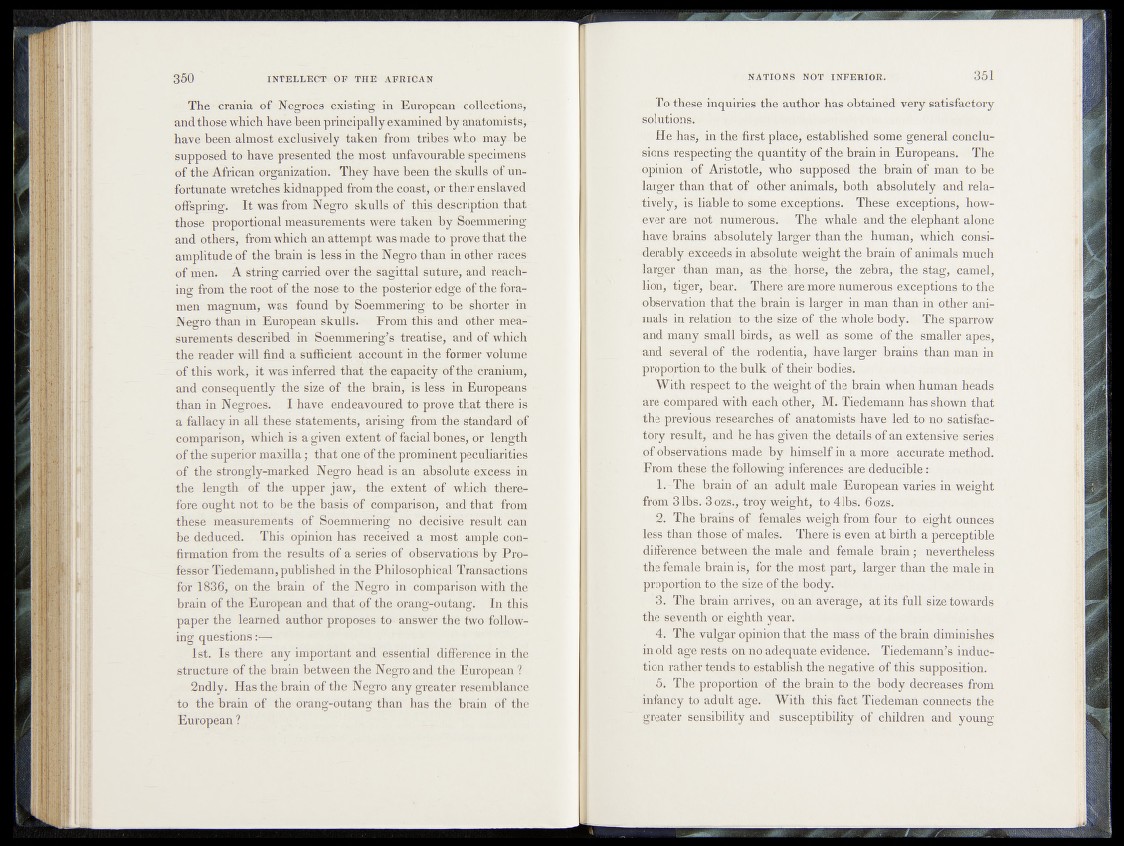
The crania of Negroes existing in European collections,
and those which have been principally examined by anatomists >
have been almost exclusively taken from tribes who may-be
supposed to have presented the most unfavourable Specimens
of the African organization. They have been the skulls of unfortunate
wretches kidnapped from the coast, or their enslaved
offspring. It was from Negro skulls of this description that
those proportional measurements were taken by Soemmering
and others, from which an attempt was made to prove that the
amplitude of the brain is less in the Negro than in otHef'races
of men. A string carried over the sagittal suture, and reaching
from the root of the nose to the posterior edge of the foramen
magnum, was found by Soemmering to be shorter in
Negro than in European skulls. From this and other mea*-
surements described in Soemmering’s treatise, and of which
the reader will find a sufficient account in the former volume
of this work, it was inferred that the capacity of the cranium,
and consequently the size of the brain, is less in Europeans
than in Negroes. I have endeavoured to prove that there is
a fallacy in all these statements, arising from the standard of
comparison, which is a given extent of facial bones, or length
of the superior maxilla; that one of the prominent peculiarities
of the strongly-marked Negro head is an absolute excess in
the length of the upper jaw, the extent of which therefore
ought not to be the basis of comparison, and that from
these measurements of Soemmering no decisive result can
be deduced. This opinion has received a most ample confirmation
from the results of a series of observations by Professor
Tiedemann, published in the Philosophical Transactions
for 1836, on the brain of the Negro in comparison with the
brain of the European and that of the orang-outang. In this
paper the learned author proposes to answer the two following
questions-
1st. Is there any important and essential difference in the
structure of the brain between the Negro and the European ?
2ndly. Has the brain of the Negro any greater resemblance
to the brain of the orang-outang than has the brain of the
European ?;
To these inquiries the author has obtained very satisfactory
.solutions.
He has, in the first place, established some general conclusions
respecting the quantity of the brain in Europeans. The
opinion of Aristotle, who supposed the brain of man to be
larger than that of other animals, both absolutely and relatively,
is Liable to some exceptions. These exceptions, however
are i nof numerous. The whale and the elephant alone
have brains absolutely larger than the human, which considerably
exceeds in absolute weight the brain of animals much
larger than man, as th& horse, the zebra, the stag, camel.,
lion, tiger, bear. . There are more numerous exceptions to the
observation that the brain is larger in man than in other animals
in relation to the size of the whole body. The sparrow
and many small birds,1 as well? as some o f the smaller apes,
and several of the rodentia, have larger brains than man in
proportion to the bulk of their bodies.
With respect to the weight of the brain when human heads
are eoinpared with each other, M. Tiedemann has shown that
the previous researches of anatomists have led to no satisfactory
result, and he has given the details of an extensive series
of observations made by himself in a more .accurate method.
From these the following inferences are deducible:
1. —The brain of an adult male European varies in weight
from 3 lbs. 3 ozs., troy Weight, to 41hii 6ozs.
2. The braids of females weigh from four to eight ounces
less than those of males. There is even at birth a perceptible
difference between the male and female brain; nevertheless
the female brain is* for the most part, larger than the male in
proportion to the size of the body.
3. The brain arrives, on an average, at its full size to wards
the seventh or eighth year.
4. The vulgar opinion that the mass foi the brain diminishes
in old age rests on no adequate evidence. Tiedemann’s inducr
tion rather tends to establish the negative of this supposition.
5. The proportion of the brain to the body decreases from
infancy to adult age. With this fact Tiedeman connects the
greater sensibility and susceptibility of children and young